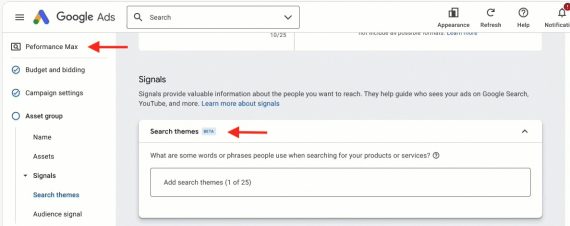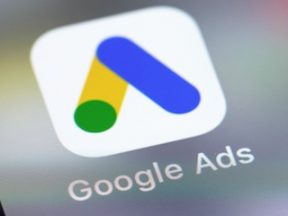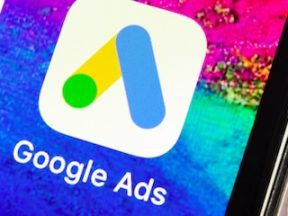A new audience targeting feature in Google Ads Performance Max campaigns could empower advertisers and improve results.
The beta feature, “search themes,” began its rollout to select Google Ads accounts earlier this fall, with widespread availability on October 26, 2023.
Google’s automated Performance Max campaigns are the most recent evolution of the company’s advertising services.
Search Themes
Performance Max has relied on assets, feeds, and landing pages to predict optimal placements. However, with search themes, advertisers can now add custom information about their business.
Search themes inform Google’s AI about a business or customers that might not be immediately discernible. For instance, if a company’s landing page doesn’t fully detail a new product or service, search themes could help target the right audience.
Here is how search themes could work.
- Add search themes. Performance Max advertisers can now add 25 unique search themes per asset group. Advertisers originate their own custom themes, akin to keywords. Some themes, such as “kitchen” and “culinary,” might have the same audience.
- Prioritization in Search inventory. Search themes are equivalent to phrase match and broad match keywords in Search campaigns. However, exact-match keywords that align perfectly with search queries will still take precedence over search themes and other keywords.
- Enhanced control. Advertisers have tools such as brand exclusions to help control the types of search traffic suitable for Performance Max.
Beyond broadening reach, the feature also enhances precision. By combining human expertise with Google’s AI capabilities, advertisers (hopefully) ensure their ads are more relevant, leading to better performace.
Tools such as search themes underscore the importance of blending human insight with machine intelligence.
About Performance Max
At the heart of PMax is machine learning and automation. Google’s algorithms analyze many data points, from user behavior to market trends, to optimize ad placements dynamically. This ensures ads appear in front of the right audience at opportune moments.
Performance Max campaigns offer many advantages. A unified approach means advertisers have a consistent presence across all Google platforms, such as Search and YouTube, for example. This consistency, combined with the campaign’s dynamic optimization capabilities, helps ads align with conversion goals, such as brand awareness, lead generation, or sales.
Furthermore, the potential for increased reach cannot be overstated. With Performance Max, businesses can tap into new audience segments, drive more traffic, and achieve better sales outcomes.
PMax Search Themes
Performance Max campaigns have relied on a set approach — analyzing assets, feeds, and landing pages. This structure allowed Google’s AI to predict where and when to place ads for optimal engagement and conversion. However, the approach had limitations.
One was the dynamic nature of business, especially ecommerce. Assets might not reflect the most recent promotions, products, or market shifts, leading to missed opportunities from AI using outdated info.
Enter search themes. It acts as an additional data layer, allowing advertisers to supply their own insights, bridging the gap between PMax’s automation and advertisers’ realities.
For instance, consider a merchant introducing a new product line. Without “search themes,” Google’s AI might not immediately recognize the relevance of this new offering. Ditto for a retailer’s seasonal sale or a B2B seller entering a niche market segment. Search themes can pinpoint specific interests, ensuring ads resonate with the right demographic.
AI in Advertising
AI represents a seismic shift in digital advertising. Gone are the days of static campaigns and manual optimizations. Today, AI drives dynamic, responsive, and highly targeted ads — responding to market trends, user behaviors, and other data points.
Moreover, AI can streamline repetitive tasks. Marketers can delegate routine activities to algorithms, freeing time for strategy and decision-making.
Improved targeting and personalization are also outcomes of AI-driven marketing. Using vast data, algorithms can craft messages that resonate with individual users, enhancing engagement and conversions.
However, there’s a balance. While AI offers unparalleled efficiency and precision, the human touch remains irreplaceable. Marketers must leverage AI’s capabilities while retaining control, ensuring campaigns align with brand values and resonate authentically with audiences.
AI’s influence on advertising will surely dramatically increase. Tools such as Performance Max and features like search themes are the start. As technology advances, expect ever-more sophisticated and effective AI-driven ads, reshaping how brands connect with their audiences.





